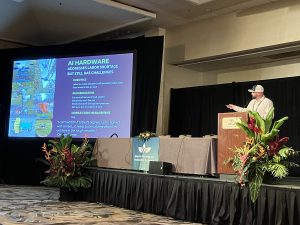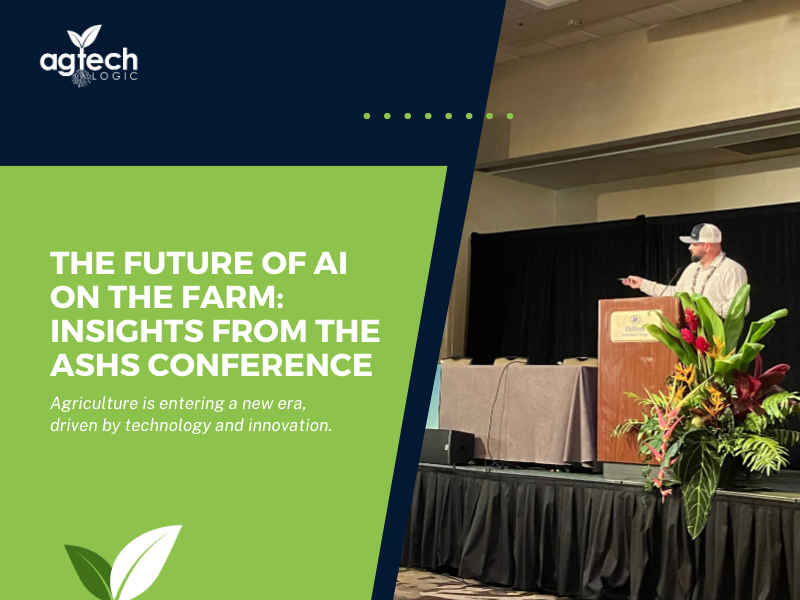Agriculture is entering a new era, driven by technology and innovation. At the recent American Society of Horticultural Science (ASHS) Conference in Hawaii, academic and industry leaders, researchers, and innovators gathered to discuss the transformative impact of Artificial Intelligence (AI) on farming. Hosted by Milt McGiffen from UC Riverside, the AI Colloquium explored how innovative AI solutions are moving from theory to tangible applications, helping growers optimize their operations and reduce environmental impact. AgTechLogic’s CTO, Justin Hoffman, presented groundbreaking advancements in AI-powered precision agriculture, showcasing how data-driven insights can enhance decision-making and ultimately lead to higher yields and more sustainable practices.
The AI Frontier in Agriculture
The farming industry is no stranger to technology, but AI represents a new frontier—one that few companies have yet to implement in a practical, real-world way. This talk covered a cross-section of advanced AI technologies and explored how they are shaping the future of agriculture. The goal is to not only think big but also turn those dreams into reality by providing farmers with actionable insights from their data.
Deploying AI directly on the farm comes with challenges. While many companies rely on cloud-based solutions for data collection and analysis, operating AI software at the edge requires a robust infrastructure. Creating a data pipeline for large-scale use is not an easy task. Picture this: you’ve trained a complex AI model using advanced technology across multiple GPUs and labeled thousands of images to detect things like weeds, strawberries, or grape bunches. Now, you need a system to deploy that model efficiently, transforming your AI project into a major data engineering challenge.
But once the model is deployed, the challenge is not over. The real difficulties lie in transforming raw data into actionable insights for farmers. They need more than just numbers — they need forecasts on soil health, crop yield, accurate harvest timing estimates, and precise weed counts. The potential applications are vast, but it’s the ability to turn these insights into invaluable actions that truly makes a difference.

Robotics: Addressing Labor Shortages with AI-Driven Automation
Labor shortages are a constant challenge in agriculture. During a recent visit to a rhubarb farm in Oregon, a grower emphasized the need to transition to robotics due to the diminishing labor force. Robotics goes beyond simple automation, it’s about harnessing AI to boost precision and productivity. These same AI models and systems used for detecting objects can also power robots equipped with advanced processors. The robots can then use the information to take real-world actions, such as planting, identifying and picking crops, and sorting and packing for shipment.
For example, a harvesting robot can detect a perfectly ripe strawberry, use depth-sensing cameras to position its arm, and pick the fruit autonomously. Fully autonomous mowers can operate around the clock, covering fields 24/7 and freeing up human resources for more complex tasks. As the industry works around increasing labor constraints, these AI-powered solutions provide a path forward.
A Vision for the Future: Tech-Integrated Farming Operations
What if, over the next few decades, we could build a more seamlessly integrated ecosystem for agriculture? Imagine a world where every piece of technology—from aerial spray drones to soil moisture detectors—communicates and collaborates. Drones could capture multispectral images to identify crop health, precision sprayers would apply herbicide precisely where needed, and robots can lead to increased efficiency by automating labor-intensive tasks.
This vision is not just a fantasy, it is becoming reality. AI innovation is transforming agriculture, where every aspect of farming—from aerial drones to robotic harvesters—work together seamlessly to optimize harvests and reduce waste. The future of farming lies in integrating technology to provide growers with actionable insights that turn data into smarter, more efficient decisions.

